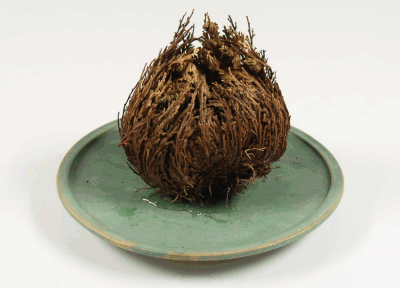By EnigmaticMindX via https://imgur.com/4Pa9zdN
It is understandable why one would look at the crispy brown bundle of a Selaginella lepidophylla and think that it was dead. No wonder then why this hardy spikemoss has become such a novelty item for those looking for a unique gift. Indeed, even the common name of "resurrection plant" suggests that this species miraculously returns from the dead with the simple addition of water. A dormant resurrection plant is far from dead, however. It is in a state of dormancy that we are still struggling to understand.
Selaginella lepidophylla is native to the Chihuahuan desert, spanning the border between the US and Mexico. This is a harsh habitat for most plants, let alone a Lycophyte. However, this lineage has not survived hundreds of millions of years by being overly sensitive to environmental change and S. lepidophylla is a wonderful reminder of that.
As you can probably imagine, tolerating near-complete desiccation can be pretty beneficial when your habitat receives an average of only 235 mm (9.3 in) of rain each year. A plant can either store water for those lean times or go dormant until the rains return. The latter is exactly what S. lepidophylla does. As its water supply dwindles, the whole body of the plant curls up into a tight ball and waits. With little in the way of roots anchoring it to the ground, dormant plants are often at the mercy of the winds, which blows them around like a tiny tumbleweed until they are wedged into a crack or crevice.
Photo by Gary Nored licensed under CC BY-NC 2.0
When the rains return, S. lepidophylla needs to be ready. Wet this crispy bundle and watch as over the course of about a day, the dormant ball unfurls to reveal the stunning body of a photosynthetic spikemoss ready to take advantage of moist conditions. Such conditions are short lived, of course, so after a few days drying out, the plant shrivels up and returns to its dormant, ball-like state. How does the plant manage to do this? Why doesn't it simply die? The answer to these questions has been the subject of quite a bit of debate and investigation.
What we do know is that part of its success has to do with curling up into a ball. Without water in its tissues, its sensitive photosynthetic machinery would easily become damaged by punishing UV rays. By curling up, the plant essentially shelters these tissues from the sun. Indeed, plants that were kept from curling up experienced irreversible damage to their photo systems and were not as healthy as plants that did curl up. To this, the plant owes its success to rather flexible cell walls. Unlike other plants that snap when folded, the cells of S. lepidophylla are able to fold and unfold without any major structural damage.
As far as metabolism and chemistry is concerned, however, we are still trying to figure out how S. lepidophylla survives such drastic shifts. For a while it was thought that, similar to other organisms that undergo such dramatic desiccation, the plant relies on a special sugar called trehalose. Trehalose is known to bind to important proteins and membranes in other desiccation-tolerant organisms, thus protecting them from damage and allowing them to quickly return to their normal function as soon as water returns.
An analysis of non-desiccating Selaginella species, however, showed that S. lepidophylla doesn't produce a lot of trehalose. Though it is certainly present in its tissues, more wet-loving species of Selaginella contain much higher amounts of this sugar. Instead, it has been found that other sugars may actually be playing a bigger role in protecting the inner workings of this plant. Sorbitol and xylitol are found in much higher concentrations within the tissues of S. lepidophylla, suggesting that they may be playing a bigger role than we ever realized. More work is needed to say for sure.
Finally, it would appear that S. lepidophylla is able to maintain enzyme activities within its cells at much higher levels during desiccation periods than was initially thought possible. When dried, some enzymes were found to be working at upwards of 75% efficiency of those found in hydrated tissues. This is really important for a plant that needs to respond quickly to take advantage of fleeting conditions. Along with quick production of new enzymes, this "idling" of enzymatic activity during dormancy is thought to not only protect the plant from too much respiration, but also allows it to hit the ground running as soon as favorable conditions return.
Despite our lack of understanding of the process, it is amazing to watch this resurrection plant in action. To see something go from a death-like state to a living, photosynthetic organism over the course of a day is truly a marvel worth enjoying.
Further Reading: [1]

